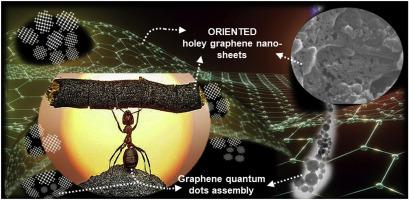Our official English website, www.x-mol.net, welcomes your feedback! (Note: you will need to create a separate account there.)
Graphene quantum dots induced porous orientation of holey graphene nanosheets for improved electrocatalytic activity
Carbon ( IF 10.9 ) Pub Date : 2021-01-01 , DOI: 10.1016/j.carbon.2020.09.031 Mumtaz Ali , Rabia Riaz , Aima Sameen Anjum , Kyung Chul Sun , Hui Li , Sung Hoon Jeong , Min Jae Ko
Carbon ( IF 10.9 ) Pub Date : 2021-01-01 , DOI: 10.1016/j.carbon.2020.09.031 Mumtaz Ali , Rabia Riaz , Aima Sameen Anjum , Kyung Chul Sun , Hui Li , Sung Hoon Jeong , Min Jae Ko

|
Abstract Complex electrolyte diffusion through the stacked graphene nanosheets limits their electrochemical performance. As a potential solution, this study explored the potential of nitrogen-doped graphene quantum dots (NGQDs) to induce 3D porous orientation of holey graphene oxide (hGO) nanosheets. The sizes of NGQDs and antisolvent for phase separation assisted assembly were optimized to achieve a 3D nanoporous network. This nano-network serves as a soft template for the porous orientation of hGO, forming a 3D hierarchically porous carbon architecture. Benefiting from the porosity of the 3D framework, π-π restacking was radically avoided, providing high electrolyte transport rates. In addition, doped nitrogen and J-type aggregation of NGQDs effectively tuned the band structure to realize charge transfer at low overpotential. The enhanced electrocatalytic activity and exceptionally low charge transfer resistance of the composite structure were attributed to the enhanced electrode/electrolyte interface and multidimensional charge & electrolyte transport. Porous composite structure based counter electrode showed 78% enhanced photovoltaic performance (compared to unmodified graphene) in the dye-sensitized solar cell, which is comparable to the performance of Pt electrode. The proposed 3D porous orientation can be utilized in emerging electrocatalytic applications, such as supercapacitors, water splitting, and battery electrodes.
中文翻译:

石墨烯量子点诱导多孔石墨烯纳米片的多孔取向以提高电催化活性
摘要 通过堆叠石墨烯纳米片的复杂电解质扩散限制了它们的电化学性能。作为一种潜在的解决方案,本研究探索了掺氮石墨烯量子点 (NGQD) 在诱导多孔氧化石墨烯 (hGO) 纳米片的 3D 多孔取向方面的潜力。用于相分离辅助组装的 NGQD 和反溶剂的尺寸经过优化,以实现 3D 纳米多孔网络。该纳米网络作为 hGO 多孔取向的软模板,形成 3D 分层多孔碳结构。受益于 3D 框架的孔隙率,从根本上避免了 π-π 重堆叠,提供了高电解质传输速率。此外,NGQDs 的掺杂氮和 J 型聚集有效地调整了能带结构,以实现低过电位下的电荷转移。复合结构增强的电催化活性和极低的电荷转移电阻归因于增强的电极/电解质界面和多维电荷和电解质传输。基于多孔复合结构的对电极在染料敏化太阳能电池中显示出 78% 的光伏性能增强(与未改性的石墨烯相比),与 Pt 电极的性能相当。所提出的 3D 多孔取向可用于新兴的电催化应用,例如超级电容器、水分解和电池电极。基于多孔复合结构的对电极在染料敏化太阳能电池中显示出 78% 的光伏性能增强(与未改性的石墨烯相比),与 Pt 电极的性能相当。所提出的 3D 多孔取向可用于新兴的电催化应用,例如超级电容器、水分解和电池电极。基于多孔复合结构的对电极在染料敏化太阳能电池中显示出 78% 的光伏性能增强(与未改性的石墨烯相比),与 Pt 电极的性能相当。所提出的 3D 多孔取向可用于新兴的电催化应用,例如超级电容器、水分解和电池电极。
更新日期:2021-01-01
中文翻译:

石墨烯量子点诱导多孔石墨烯纳米片的多孔取向以提高电催化活性
摘要 通过堆叠石墨烯纳米片的复杂电解质扩散限制了它们的电化学性能。作为一种潜在的解决方案,本研究探索了掺氮石墨烯量子点 (NGQD) 在诱导多孔氧化石墨烯 (hGO) 纳米片的 3D 多孔取向方面的潜力。用于相分离辅助组装的 NGQD 和反溶剂的尺寸经过优化,以实现 3D 纳米多孔网络。该纳米网络作为 hGO 多孔取向的软模板,形成 3D 分层多孔碳结构。受益于 3D 框架的孔隙率,从根本上避免了 π-π 重堆叠,提供了高电解质传输速率。此外,NGQDs 的掺杂氮和 J 型聚集有效地调整了能带结构,以实现低过电位下的电荷转移。复合结构增强的电催化活性和极低的电荷转移电阻归因于增强的电极/电解质界面和多维电荷和电解质传输。基于多孔复合结构的对电极在染料敏化太阳能电池中显示出 78% 的光伏性能增强(与未改性的石墨烯相比),与 Pt 电极的性能相当。所提出的 3D 多孔取向可用于新兴的电催化应用,例如超级电容器、水分解和电池电极。基于多孔复合结构的对电极在染料敏化太阳能电池中显示出 78% 的光伏性能增强(与未改性的石墨烯相比),与 Pt 电极的性能相当。所提出的 3D 多孔取向可用于新兴的电催化应用,例如超级电容器、水分解和电池电极。基于多孔复合结构的对电极在染料敏化太阳能电池中显示出 78% 的光伏性能增强(与未改性的石墨烯相比),与 Pt 电极的性能相当。所提出的 3D 多孔取向可用于新兴的电催化应用,例如超级电容器、水分解和电池电极。

























 京公网安备 11010802027423号
京公网安备 11010802027423号